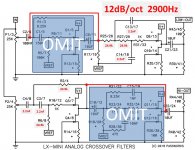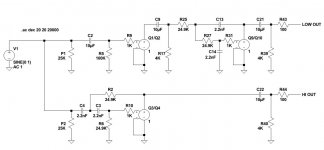Thank you for the answer.
I changed the schematic.
Does this correctly reflect your opinion?
On the low pass, Vref gets shorted to ground. Move the red line to the other side of C2/6.
Papa
I don't understand the purpose of including C2/6 and R17/19 in the LOW-OUT section. The HI-OUT section does not contain the equivalent.
I don't understand the purpose of including C2/6 and R17/19 in the LOW-OUT section. The HI-OUT section does not contain the equivalent.
The RC combo couples the AC signal to the filter, and C2/6 isolates the DC voltages to maintain the filter's DC operating points. Without C2/6, the DC voltages will have paths to ground.
The RC combo couples the AC signal to the filter, and C2/6 isolates the DC voltages to maintain the filter's DC operating points. Without C2/6, the DC voltages will have paths to ground.
Then would it not be better to change the value of C2/3 to 10uf? Or connect the wiper of P1/3 directly to the positive side of C9/10?
For the 12dB / oct network I need, I need to bypass some, but is it correct as my pic?
I am not confident that R17-20 is unnecessary.
Out of curiosity, I decided to model this. Attached is LTSpice model with component numbers that relate to the PCB. I kept the LOW-OUT section one input buffer since it was available and easy to use. R17, R39 and R40 are nominal and should be the values specific to the supplied JFETS.
Attachments
Last edited:
Here's a pic
''I have a crossover ready for the store which is 6,12,18,24 dB/oct high pass
and low pass for each channel, and this might be appropriate for you ''
I need one, or two 😀
diyaudiostore ANALOG CROSSOVER NETWORK: BASIC KIT
Hi Nelson,
Your crossover network just came back into stock today at the diyaudiostore. Unfortunately, the basic kit PC board appears to still be the old version marked BIAMP12ERF-V1R0 (C)1998. How do I get the new board version referenced in your post above ?
You don't seem to need the EQ circuits of the LXmini, so maybe an
ordinary flexible crossover would work for you.
I have a crossover ready for the store which is 6,12,18,24 dB/oct high pass
and low pass for each channel, and this might be appropriate for you.
You can adjust each pole of the filters individually +/- 1 octave around
a frequency determined by capacitors you install - all the caps are the
same value to make life easier.
If you cascade low pass and high pass filters, you have band pass, and
a 4 way system would require 3 of these boards for stereo
The base kit is the board plus selected Jfets.
I expect that it's cost will be competitive, so perhaps you would like to try it.
Hi Nelson,
Your crossover network just came back into stock today at the diyaudiostore. Unfortunately, the basic kit PC board appears to still be the old version marked BIAMP12ERF-V1R0 (C)1998. How do I get the new board version referenced in your post above ?
Correction: BIAMP12ERF-V1R0 (C)2018 in diyaudiostore
Correction: The current crossover PC Board shows: BIAMP12ERF-V1R0 (C)2018 at diyaudiostore.com
Hi Nelson,
Your crossover network just came back into stock today at the diyaudiostore. Unfortunately, the basic kit PC board appears to still be the old version marked BIAMP12ERF-V1R0 (C)1998. How do I get the new board version referenced in your post above ?
Correction: The current crossover PC Board shows: BIAMP12ERF-V1R0 (C)2018 at diyaudiostore.com
At this moment the project is being documented and then will be released.
As I have multiple things going on (including doing tax returns) it will still
be several weeks. However I expect that it will be worth the wait.
As I have multiple things going on (including doing tax returns) it will still
be several weeks. However I expect that it will be worth the wait.
As I have multiple things going on (including doing tax returns) QUOTE]
I'm pleased to hear audio celebrities can't escape one of the two inevitable consequences of life.
I'm so enjoying Steve G's YouTube videos. Thanks Mr Pass.
Interested
I would be interested in this.
Any idea when it would be in the store?
Thank you.
You don't seem to need the EQ circuits of the LXmini, so maybe an
ordinary flexible crossover would work for you.
I have a crossover ready for the store which is 6,12,18,24 dB/oct high pass
and low pass for each channel, and this might be appropriate for you.
You can adjust each pole of the filters individually +/- 1 octave around
a frequency determined by capacitors you install - all the caps are the
same value to make life easier.
If you cascade low pass and high pass filters, you have band pass, and
a 4 way system would require 3 of these boards for stereo
The base kit is the board plus selected Jfets.
I expect that it's cost will be competitive, so perhaps you would like to try it.
I would be interested in this.
Any idea when it would be in the store?
Thank you.
I'm not sure how the 4343A input terminal and switching works. If switching to the biamp mode gives direct access to the 10" mid range voice coil as well as to the 15" woofer voice coil, then 12dB/oct symmetrical would probably be appropriate. Linkwitz-Riley alignment is usually recommended because it gives flat power response through the pass band. The reason I ask about direct connection to the 10" voice coil is that my ADS L980 speakers, when switched to biamp mode, give direct access to the 12" woofer but still keep the passive HP filter connection to the 2" mid range - probably to avoid potential driver damage. So I run 12dB/oct active to the mid/highs which adds to the 12dB/oct passive to give 24dB/oct. Then I run 24dB/oct active to the woofer to match the response.
Hi Ac,
I did you see your post until now.
If you wish to follow the authenticity of JBLs approach to Biamp operation of this 4343 monitor I recommend these crossover settings:
Low pass 2nd order butterworth 229 hertz Q 0.707
High pass 2nd butterworth 281 hertz W 0.707
The above solution was derived empirically by Jbl after measurement of prototypes of this monitor. What they discovered was acoustic mutual coupling of the 10 inch 2121A mid cone and the 15 inch 2231A woofer on the 4353 baffle caused a 2db hump around the crossover point using std butterworth filters. The subjective result was sub optimal. Using an empirical approach Jbl spread the crossover points per the above solution.
As an example it’s worth pointing out that active crossovers are not a short cut to utopian plug and play loudspeakers crossover networks. They never were and never will be.
A common misnomer is the LR24 dB filter that will sum correctly at the crossover point.
The summation requires the correct acoustic slopes of the drivers and phase alignment to meet the LR transfer function. This typically requires offset alignment delay in the low or high pass filters. The voltage drive of the active crossover should not be confused with the real acoustic response of the drivers which requires careful measurement. The inductance of a woofer will impact on the voltage driver of an active low pass filter. So this requires measurement with suitable equipment.
The difference in a plug and play solution and a design based on real data is an okay result to an outstanding result.
You may wish to download REW and acquire the recommended USB calibrated mic to obtain real measurement data before commencing your active filter designs. I use Linear X LMS and Leap Crossover Shop to assist with real world active filter design. Other software is available to the audio amateur. Do not be afraid of starting your own measurements. Once you do you will never look back.
This is not a rant or a lecture on crossover network design but a heads up not to expect a miracle from an active crossover network without doing some preliminary investigation.
AV Receiver
Hello,
Simple question, can I install this crossover after the receiver?
I'm interested in building the LXmini but using a DSP with an AV Receiver is not ideal, unless I get a second amp.
Thanks
Alain
Hello,
Simple question, can I install this crossover after the receiver?
I'm interested in building the LXmini but using a DSP with an AV Receiver is not ideal, unless I get a second amp.
Thanks
Alain
ok thanks, I was afraid of that, but I can do that with the miniDSP.
What is the advantage of this crossover then? I don't get it.
So can I built a passive crossover for the LXmini? it's what I was looking for when I found out about this crossover.
I just want to use my receiver and replace my 3 way speakers with the Lxmini.
What is the advantage of this crossover then? I don't get it.
So can I built a passive crossover for the LXmini? it's what I was looking for when I found out about this crossover.
I just want to use my receiver and replace my 3 way speakers with the Lxmini.
The benefit of this analog crossover is that it is analog. If you have a turntable/preamp or a DAC you really like you play your music with that and split the signal afterward. Still will need 4 channels of amplification after the crossover. Not sure how your AVR fits in to your plans, but there are 2 ways it could be used.
Source > AVR > preouts to analog crossover > 4 channels of amplification > 2way speakers
Source > preamp/DAC > analog crossover > AVR multichannel inputs > AVR > 2way speakers
I am not aware of any passive crossovers for the LX-mini.
Source > AVR > preouts to analog crossover > 4 channels of amplification > 2way speakers
Source > preamp/DAC > analog crossover > AVR multichannel inputs > AVR > 2way speakers
I am not aware of any passive crossovers for the LX-mini.
- Home
- Amplifiers
- Pass Labs
- LX-mini Crossover Article


